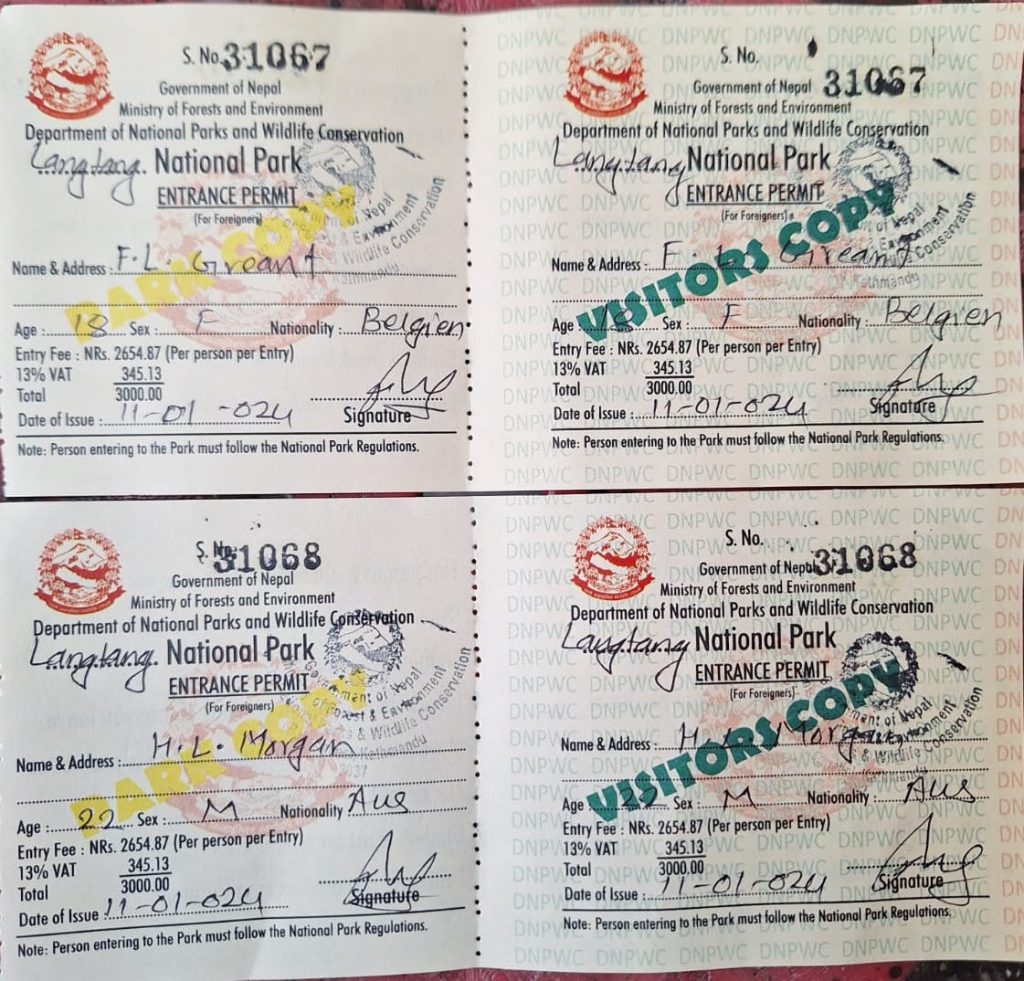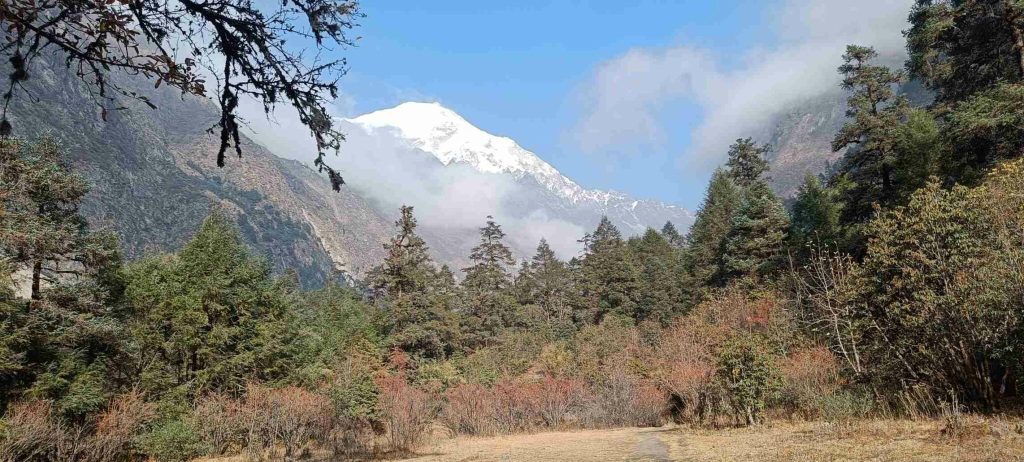Best Time To Trek Langtang Gosaikunda in Nepal
The Langtang Gosaikunda trek is among the most captivating and remarkable treks Nepal offers. Combining the lush greenery and sacred lakes, the Langtang Gosaikunda trek is considered the perfect balance of adventure and cultural exposure. As you walk through the majestic bamboo and rhododendron forests, you get to see the home of diverse wildlife, and if you get lucky, you may even see the elusive and rare red panda alongside other wildlife.
The Langtang Gosaikunda trek is considered a moderately difficult level trek. Moreover, this trek combines the Langtang Valley’s serenity with the Gosaikunda Lake’s sacred waters, offering a perfect blend of an adventurous and holy journey. The best seasons to undertake the Langtang Gosaikunda Trek are autumn and spring. The weather during these seasons is the most favorable for the trekkers. However, trekking to Langtang Gosaikunda can be done in summer and winter. Still, we recommend being mindful of the challenges of these times and trekking with utmost safety and preparation during this season.
Factors to Consider While Trekking Gosaikunda
When trekking to Gosaikunda, it is important to consider factors such as weather, seasons, permits, and the chosen route. These aspects ensure a safe and enjoyable journey, contributing to an exciting and unforgettable experience.
1. Seasons to Travel
The best seasons to travel to Langtang Gosaikunda include autumn (September to December) and spring (March to May). Both seasons are favored because of the favorable weather and luscious flora and fauna. Autumn and spring offer you the chance to witness the angelic beauty of the mountains, and the blooming rhododendrons and wildflowers make the trail worth the best. Regardless of the season, you are likely to have a fun time when you visit Langtang Gosaikunda. The Gosaikunda lake during the winter freezes over giving it the famous title of the frozen lake. A sight that makes the challenges of winter worthwhile. And with the beginning of the monsoon rains, you get to experience a picturesque journey
Your days in the Langtang Gosaikunda will go beyond the majestic mountains. The trek not only gives you the chance to immerse yourself in nature and culture but also connects you to a global community of trekkers who come to Nepal for a similar transformative experience.
2. Route to Follow
Langtang Gosaikunda Trek is an exciting route that offers a glimpse into the culture of Nepal as well as its diverse greenery. The trek usually begins with a drive from Kathmandu to Syabrubesi, a small village in the Rasuwa district, and proceeds through the Langtang Valley. Hikers go through lush forests, rivers, waterfalls, and picturesque Tamang villages.
A highlight of this trek includes the visit to Buddhist monasteries like Kyanjin Gompa and Shin Gompa. The climax of this trek is taken at Gosaikunda Lake, which is considered sacred by Hindus and Buddhists. From the top of Lauribina Pass, one can return by following the Chisapani route and reach Sundarijal for a drive back to Kathmandu to end the trek.
3. Permits and Regulations

Every trekker who visits the Langtang Gosaikunda has to get a permit. Note that these permits are mandatory and made with your interest in mind.
- TIMS (Trekkers’ Information Management System) Card: The TIMS (Trekkers’ Information Management System) Card is an important document for trekking in the Langtang region. The TIMS card was first introduced in 2008 and functions as a database for hikers, offering vital information for safety and legal requirements. A policy update effective from April 1, 2023, states that you cannot get a TIMS card on your own. This means that in order to obtain a TIMS card, you must trek with a local business. For residents of SAARC nations, a TIMS card costs roughly USD 10. It costs about USD 20 for other foreign hikers as well. To obtain your TIMS card, you must present a copy of your passport along with two passport-sized photos.
- Langtang National Park Entry Permit: For Langtang Valley Trek, you must get an entry permit to Langtang National Park. The licenses are available at the Dhunche or Kathmandu offices of the Nepal Tourism Board. This entry permit is $30 for non-resident foreigners and $15 for residents of SAARC countries. There is no fee for entry permits for children under ten who are trekking with you.
4. Physical Fitness and Preparation
Maintaining physical fitness is pivotal for successfully completing the Gosaikunda and Langtang Valley trek. The trekkers will cover around 177 km, walking 4-6 hours daily over difficult, high-altitude terrain. To prepare, it is recommended to start training 2-3 months before the trek. Cardiovascular fitness, such as walking, jogging, and cycling, helps improve endurance for high-altitude trekking. Strength training is instrumental in building physical resilience, while endurance training can involve brisk walking, swimming, or hiking. Mental preparation, including yoga and meditation, enhances focus and stamina. A balanced diet rich in nutrients and proper hydration is also vital to support physical and mental health and prevent altitude sickness.
5. Accommodation and Facilities During the Trek
Accommodations during the Gosaikunda Trek are mainly teahouses, which offer basic lodging along the route. Teahouses will usually provide basic rooms and are also available in highlight places like Syabrubesi, Langtang Village, Kyanjin Gompa, Thulo Syabru, and Chisopani. The accommodation is usually quite comfortable; however, the quality sometimes differs or can be somewhat basic in less frequented areas.
There are plenty of hotels along the way that offer accommodation. To get the local experience, tea houses are the recommended lodging option. Most meals at the tea houses along the route allow a varied selection of both local and international dishes, though choices will become very limited at higher altitudes. On the whole, teahouse accommodations offer very functional and vital support to trekkers- a good balance between basic comfort and the unique experience of staying in remote areas of the Himalayas.
6. Weather and Temperature at Gosaikunda
The Langtang Gosaikunda trek experiences a myriad of temperatures and weather conditions across different seasons. Spring (March to May) offers the best trekking conditions as the weather is warm, the skies are clear, and Typically, temperatures range from 10 to 20°C during the daytime and drop to 0 to 5°C during the nighttime. The stable and clear weather this season offers results in fewer interruptions during your trek. Autumn season (September to November) will offer post-monsoon weather, enhancing the majestic landscapes of the mountains and the blooming flora. Daytime temperatures generally range from 10°C to 25°C, offering comfortable conditions for long treks, while at higher elevations, nighttime temperatures can drop to between -5°C and 0°C.
While the winter season (December to February) brings more harsh conditions (risk of avalanche, difficult trails, and extremely cold weather) giving way to the stunning snow-covered mountain peaks, daytime temperatures can range from -5°C to 5°C and drop to -10°C to -15°Cduring the nighttime. Summer season on the other hand (June to August) usually coincides with the monsoon months in Nepal making the trails muddy and difficult to navigate. Regardless of which the rain enhances the natural beauty of the flora. Daytime temperatures range from 15°C to 25°C and the nighttime temperatures can drop to 5°C to 10°C at high elevations.
Best Seasons to Trek Gosaikunda

The best seasons to trek Langtang Gosaikunda are autumn (September to November) and spring (March to May). While other seasons have their own beauty to them, these periods offer mild weather, clear skies, and blooming rhododendrons that make for an unforgettable trekking experience.
Trek to Gosaikunda in Autumn: September-October-November
The recommended season to trek in Langtang Gosaikunda Trek is autumn (September to November). The temperatures during the day generally range from 10°C to 25°C, making it comfortable for long treks. At higher elevations, nighttime temperatures can drop to between -5°C and 0°C. Following the monsoon season, the trails are well-maintained and dry. And the post-monsoon air clears up the skies, allowing for breathtaking views of the Himalayan peaks, including Langtang Lirung, and Dorje Lakpa. You’ll experience the thriving flora and fauna, as well as visit key cultural sites such as Buddhist monasteries, Tamang villages, and Gosaikunda Lake.
The natural beauty of the trek is at its peak with the landscape showcasing the vibrant colors of fall. The autumn season is also a busy time for local festivals, adding a cultural dimension to the trek. Festivals like Dashain and Tihar are celebrated, providing trekkers a chance to experience local customs and festivities. The Tamang villages and Buddhist monasteries along the route are more active, offering richer cultural interactions.
Trek to Gosaikunda in Spring: March to May
Spring season is considered one of the best seasons to trek in Langtang Gosaikunda. The season offers comfortable temperatures ranging from 10`C TO 20` during the day and dropping to 0 to 5` C during the nighttime. The stable and clear weather of this season allows for fewer disruptions during your trek. The spring season with its clear weather offers the stunning view of the Himalayan peaks and the stunning landscapes of the Langtang Gosaikunda trek.
The trail also comes to life with the vibrant colors of the rhododendrons and other exotic flora that enrich your experience. Despite being the peak season you can still enjoy the vibrant nature of Langtang Gosaikunda with the right experts and equipment.
Trek to Gosaikunda in Winter: December to February
The winter season in Gosaikunda can be a mesmerizing experience for the trekkers. The daytime temperatures can range from -5`C to 5`C and drop to -10`C to -15`C during the nighttime. The temperature during winter can pose a significant challenge to those for whom cold temperatures are difficult. We advise you to pack enough warm clothes and the right equipment that can make your trekking easier.
The sheer amount of snowfall makes the landscape look stunning but the trail can become icy and difficult to navigate. Trekkers are advised to be prepared for disruptions during the trek. It is highly recommended that trekkers get in contact with reliable experts that can make the trek easier.
Trek to Gosaikunda in Summer: June to August
The summer season in Nepal coincides with the monsoon season. The daytime temperatures range from 15`C to 25`C and the nighttime temperatures can drop to 5`C to 10`C at high elevations. Trekkers are expected to encounter frequent rain, humidity, and cloudy skies. These factors can obstruct the view of the mountains and make the trek more time-consuming.
The frequent rain also makes the trails muddy and slippery making it difficult to navigate and more challenging. The risks of landslides can increase during this season. Regardless, the rain brings life to the blossoming flora of the trail making it visually stunning. Compared to the other seasons, the summer season sees less of a crowd making lodging and accommodation easier.
Best Time for Gosaikunda Trekking: Our Recommendation
Autumn and spring are considered to be the best seasons to trek in the Langtang Gosaikunda. With clear skies, comfortable weather, and blooming flora and fauna you can get the best experience of trekking in Nepal. Trekking in these seasons allows you to fully immerse yourself in the country’s stunning landscapes while engaging with its rich cultural heritage at its peak.
While every season has its own beauty to it, we recommend being mindful of the challenges they bring with them. Winter and summer can be good options for trekking in the Langtang Gosaikunda trail. However, we recommend that you get the right equipment and experts to make sure the trek goes smoothly. Mountain routes in this regard can offer you the services that make this trek one of the best experiences of your life, memorable journey that stays with you forever.
